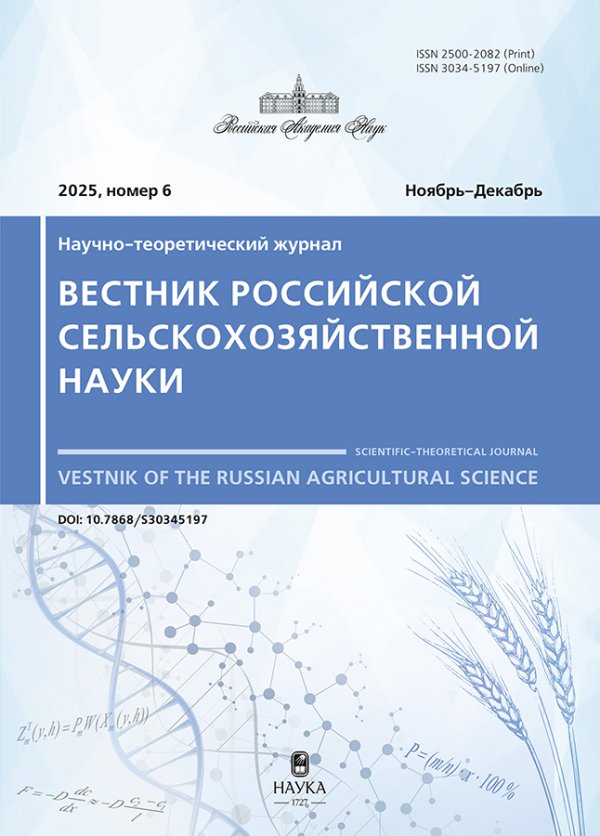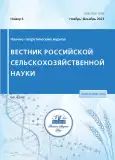Племенные показатели фермерских цесарок
- Авторы: Забиякин В.А.1, Замятин С.А.2, Максуткин С.А.2
-
Учреждения:
- Марийский научно-исследовательский институт сельского хозяйства - филиал ФГБНУ «Федеральный аграрный научный центр Северо-Востока имени Н.В. Рудницкого», ФГБОУ ВО «Марийский государственный университет»
- Марийский научно-исследовательский институт сельского хозяйства - филиал ФГБНУ «Федеральный аграрный научный центр Северо-Востока имени Н.В. Рудницкого»
- Выпуск: № 6 (2023)
- Страницы: 83-86
- Раздел: Статьи
- URL: https://journals.rcsi.science/2500-2082/article/view/233587
- DOI: https://doi.org/10.31857/2500-2082/2023/6/83-86
- EDN: https://elibrary.ru/WRFPWH
- ID: 233587
Цитировать
Полный текст
Аннотация
Об авторах
Владимир Александрович Забиякин
Марийский научно-исследовательский институт сельского хозяйства - филиал ФГБНУ «Федеральный аграрный научный центр Северо-Востока имени Н.В. Рудницкого», ФГБОУ ВО «Марийский государственный университет»
Email: zamyatin.ser@mail.ru
Сергей Анатольевич Замятин
Марийский научно-исследовательский институт сельского хозяйства - филиал ФГБНУ «Федеральный аграрный научный центр Северо-Востока имени Н.В. Рудницкого»
Сергей Аркадьевич Максуткин
Марийский научно-исследовательский институт сельского хозяйства - филиал ФГБНУ «Федеральный аграрный научный центр Северо-Востока имени Н.В. Рудницкого»
Список литературы
- Буяров В.С., Ройтер Я.С., Кавтарашвили А.Ш. и др. Оценка племенных качеств сельскохозяйственной птицы мясного направления продуктивности (обзор) // Вестник аграрной науки. 2019. № 3 (78). С. 30-38.
- Забиякин В.А., Замятин С.А. Скорость роста и мясные качества цесарок содержащихся в условиях фермерского хозяйства // Аграрная наука Евро-Северо-Востока. 2021. №22(4). С. 581-588. DOI: https://doi/org/10.30766/2072-9081.2021.22.4.581-588
- Забиякин В.А. Разведение цесарок в России // Эффективное животноводство. - 2017. № 3.(57). С. 24-28.
- Производство мяса и яиц цесарок: Методические рекомендации. Под общ. ред. Я.С.Ройтера. Сергиев Посад, 1993. 22 с.
- Ройтер Я.С., Шашина Г.В., Дегтярева Т.Н. и др. Разведение цесарок в фермерских и приусадебных хозяйствах // Птица и птицепродукты. 2017. №2. С. 29-31.
- Ройтер Я.С. Цесарки // Руководство по содержанию и разведению / М. 2014. 218 с.
- Ройтер Я.С. Использование генофонда сельскохозяйственной птицы в селекционной работе. Птица и птицепродукты. 2016. № 3. С. 45-47.
- Ройтер Я.С., Шашина Г.В., Дегтярева Т.Н. и др. Современная программа селекции цесарок // Птицеводство. 2019. № 4. С. 15-19.
- Ройтер Я.С. Гусева Н.К., Русецкая Т.П. Особенности селекционной работы с цесарками // Птицеводство. 2016. № 3. С. 7-11.
- Фисинин В.И. Генетические ресурсы сельскохозяйственных животных России // Достижения науки и техники АПК. 2014. № 8. С. 15-19.
Дополнительные файлы










